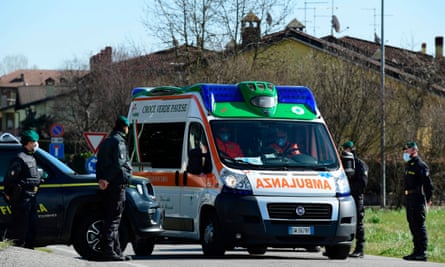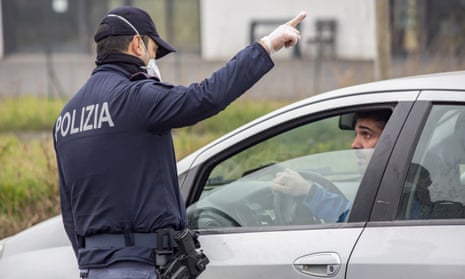Italian prosecutors have opened an investigation into the procedures adopted by hospitals in the Lombardy region at the centre of Europe’s coronavirus epidemic, amid reports doctors initially delayed testing an Italian “super-spreader”, allowing the disease to proliferate rapidly including beyond the country’s borders.
As new cases were confirmed in Spain, France, Austria, Switzerland, Croatia, Germany, Greece, Norway and Algeria, it was reported that a hospital in Lombardy, where the bulk of the infections are located, delayed testing “patient-one”, a 38-year-old man who is believed to be the first source of local transmission.
The virus has so far killed 12 people in Italy, the latest victim being a 70-year-old woman in Emilia-Romagna. Cases across the country have reached more than 400 by Wednesday night, among them five children aged between four and 15.
Police officers carried out overnight inspections on hospitals in the Lombardy towns of Codogno, the centre of the outbreak, Casalpusterlengo and Lodi.
Q&AHow can I protect myself and others from the coronavirus outbreak?
Show
The World Health Organization is recommending that people take simple precautions to reduce exposure to and transmission of the coronavirus, for which there is no specific cure or vaccine.
The UN agency advises people to:
- Frequently wash their hands with an alcohol-based hand rub or warm water and soap
- Cover their mouth and nose with a flexed elbow or tissue when sneezing or coughing
- Avoid close contact with anyone who has a fever or cough
- Seek early medical help if they have a fever, cough and difficulty breathing, and share their travel history with healthcare providers
- Advice about face masks varies. Wearing them while out and about may offer some protection against both spreading and catching the virus via coughs and sneezes, but it is not a cast-iron guarantee of protection
Many countries are now enforcing or recommending curfews or lockdowns. Check with your local authorities for up-to-date information about the situation in your area.
In the UK, NHS advice is that anyone with symptoms should stay at home for at least 7 days.
If you live with other people, they should stay at home for at least 14 days, to avoid spreading the infection outside the home.
The investigation comes after the prime minister, Giuseppe Conte, blamed an unnamed hospital for contributing to the spread of the virus by failing to adhere to proper procedures.
Reporting in Italian media has focused on whether medical staff missed opportunities to identify coronavirus in patient one – identified as “Mattia” – who remains seriously ill in hospital in Pavia, south of Milan.
The man is believed to have infected his pregnant wife and a friend he went running with as well as three elderly people who frequented a bar owned by his friend’s father.
He has also been linked to eight other infections, among them health workers and patients at the hospital in Codogno, one of them reportedly being a 77-year-old woman who died of the illness on Sunday. The woman was suffering from pneumonia and tested positive for the virus postmortem.
Critics claim that emergency health guidelines introduced in late January mean that the man should have been treated as a potential suspected case, and tested, even without clear connections to China, because of his symptoms.
According to reports in the Italian media it took four contacts with doctors before the man was eventually tested for coronavirus, and then only after he had spent 36 hours at a hospital in Codogno before being put under isolation, a period during which he infected a number of other people.

Some staff at the hospital have complained that even after he tested positive it still took hours before all staff were warned of the risk.
According to details that have leaked out slowly in recent days in the midst of Italy’s escalating coronavirus crisis, it appears that the man first complained of feeling unwell around 14 February and went to his GP – also now in hospital with coronavirus – where he was given flu medication.
With his symptoms failing to improve, he then attended hospital on 16 February, returning again to A&E two days later on February 18 where he was discharged again without being tested because of a lack of any links with China.
On 19 February, just after 3am in the morning, the man, experiencing breathing difficulties, visited the hospital for a third time. On this occasion the man’s wife recalled he may have had contact with a friend recently returned from China.
Even then he was only tested for the virus 36 hours later at about 4pm on 20 February during which time he had been visited by numerous friends and family who were able to come and go freely.
While Conte did not explicitly refer to the hospital in Codogno where the first man tested positive, his comments prompted a backlash from Attilio Fontana, the regional president.
The head of medicine in Codogno also defended his hospital’s response. “We have done our duty and we have a clear conscience,” Giorgio Scanzi told Italian media. “From the first moment of the emergency we have not left our sick even for a moment. Some of us, among doctors and nurses, are infected and are now fighting against the disease.”
The investigation comes as Italy is under pressure to get to the bottom of what triggered the sudden outbreak as it spreads across Europe and beyond, despite enacting a state of emergency in late January when the virus was first detected in two Chinese tourists from Wuhan officials believe may be the initial source. The couple, who have now recovered, are also reported to have visited Parma in the north of the country.
“In all emergency departments across the world, doctors should always have in mind the so-called universal precautions that tend to consider every patient, at any time or anywhere, a potential spreader of disease,” Walter Ricciardi, an Italian medic and member of the World Health Organization’s executive board, told the Guardian.
“Sometimes, because of the pressure of the work, these can’t be entirely enforced, and I think that is what happened here. We shouldn’t blame anyone, as doctors and nurses are only doing their jobs, but if there is a mistake, we need to avoid making one again. It is also difficult as we are still in the flu season and it is very difficult to distinguish between the two.”
Italy has carried out more than 9,000 coronavirus tests since Friday. One explanation experts give for the surge in cases is that Italy has carried out a huge number of tests, particularly among people who showed few or no symptoms and who might have recovered without even knowing they had coronavirus.
The Italian government has also been criticised for hastily cancelling flights to and from China as, without coherence across Europe, people have been able to fly to other European cities and enter Italy from there.
Thermal scanners were installed at some of the main airports to check the temperature of new arrivals. “But even if you checked the temperature of all the people arriving at the airport, you cannot find all the infected people,” said Gloria Taliani, a doctor of infectious diseases in the Lombardy city of Piacenza. “Therefore this global movement of people makes it very easy for the disease to cross borders.”
